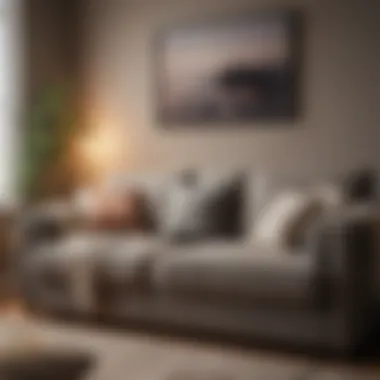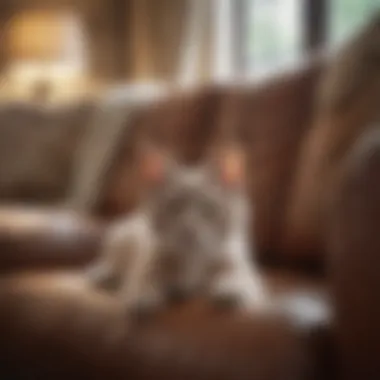Effective Strategies for Removing Odor from Your Couch


Intro
Unpleasant odors emanating from a couch can be frustrating for pet owners and others alike. The source of these smells can range from pet accidents to spilled food and sweat. The presence of these odors not only detracts from the enjoyment of your living space but can also imply a lack of cleanliness. However, addressing this issue does not have to be cumbersome. This guide outlines effective strategies for removing odors from your couch and offers preventative maintenance tips. Adopting a clean and odor-free couch is achievable with the right approach and techniques.
Understanding the Source of Odors
Before diving into the cleaning process, it is essential to identify the origin of the odors. Common causes can include:
- Pet accidents
- Food spills
- Dust and allergens
- Moisture buildup
- General wear and tear
Essential Cleaning Techniques
Effective cleaning methods vary depending on your couch material. Below are basic cleaning techniques tailored for popular fabrics:
Fabric Sofas
- Use a vacuum with an upholstery attachment to remove dust and hair.
- Mix a solution of mild detergent and warm water. Use a soft cloth to spot clean.
- For persistent stains, consider a fabric-safe upholstery cleaner.
Leather Sofas
- Wipe down with a damp cloth to remove surface dirt.
- Apply a leather conditioner to prevent cracks and maintain durability.
- Use specific leather cleaning products for deeper cleaning.
Microfiber Sofas
- Dry cloth may be used to blot up spills immediately.
- A solution of rubbing alcohol can be applied to tough stains.
- Regular vacuuming helps in maintaining the material’s integrity.
Preventive Measures
In addition to regular cleaning, taking preventive steps can significantly reduce the need for deep cleaning. Consider the following:
- Invest in couch covers that can be easily washed.
- Implement a no-food policy on the couch, especially for pets.
- Regular grooming of pets helps to minimize the amount of hair and dander on your couch.
- Keep windows open for ventilation; fresh air can help eliminate musty odors.
By applying these techniques and precautions, you can effectively maintain a fresh and pleasant living environment.
Understanding the Causes of Odor in Couches
Understanding the causes of odor in couches is a crucial starting point for effective odor removal. It allows homeowners, especially pet owners and families, to tailor their cleaning strategies to address specific odor types. Recognizing these causes not only improves the cleaning process but also helps in selecting the right products and methods.
Types of Odors
Couches can harbor a variety of odors. Common types include:
- Musty odors: Often the result of moisture accumulation and mildew growth.
- Chemical smells: Can come from cleaning products or even the couch material itself.
- Pet-related odors: These might stem from urine, fur, or dander.
- Food and drink smells: Spills or crumbs can create lasting odors if not addressed promptly.
Identifying the type of odor present is essential, as each type may require a different cleaning approach or product.
Common Sources of Odor
Several elements can contribute to couch odors. Some of the most frequent sources include:


- Spills and stains: Food and drink accidents leave behind residues that can attract bacteria.
- Body oils and sweat: Over time, body contact can introduce oils that lead to unpleasant odors.
- Dust and dirt: Accumulation of dust can create a stale smell, especially in fabrics.
- Mold and mildew: Couch materials that do not breathe well may trap moisture, leading to mold growth.
It is vital to consider these factors when addressing couch odors. A thorough understanding ensures that the right cleaning methods are applied before deeper issues arise.
Impact of Pets on Couch Odor
Pets can significantly influence the odor levels in a home. Their fur, dander, and waste can embed into couch fibers, leading to persistent smells. Some points to consider include:
- Urine marks: If pets urinate on the couch, it can lead to strong, lasting odors if not treated immediately.
- Furred friends: Shedding fur and dander can mix with dust, creating a smelly environment.
- Behavioral odors: Pets may carry odors from outside that transfer to furniture.
Accordingly, pet owners must adopt proactive cleaning routines to maintain a fresh-smelling couch. Addressing these odors quickly can make a noticeable difference in the overall hygiene of the living space.
Assessing Your Couch's Material
Understanding your couch's material is critical for effective odor removal. Each material reacts differently to stains and odors. Knowing the specific cleaning methods appropriate for your couch type can prevent damage and ensure a greater chance of successful odor elimination. Moreover, improper cleaning can lead to further issues, such as stains setting in or deterioration of the material. Therefore, take time to assess your couch carefully.
Fabric vs.
Leather
Couches can come in a range of materials, but the two most common are fabric and leather.
Fabric couches are often soft and can trap odors effectively, but they can also be more challenging to clean. Materials like microfiber or cotton can absorb spills and smells easily, necessitating more frequent deep cleaning. If a fabric couch has been exposed to odors for some time, you may need to employ stronger cleaning solutions or techniques.
Leather couches, on the other hand, have a slick surface that tends to repel odor particles. However, they can develop a unique set of problems. Leather may not absorb odors as fabric does, but it can become grimy and develop a musty smell if not properly maintained. Additionally, certain cleaning agents, like water or vinegar, can cause leather to crack or fade. Therefore, determine the specific type of leather before committing to any cleaning method.
Choosing the Right Cleaning Method
Choosing an appropriate cleaning method for your couch's material requires careful thought. The wrong approach can lead to increased odors or damage. Start by identifying the materials and any labels on the couch that suggest cleaning methods. Most couches come with a tag that indicates if they should be cleaned with water, solvent, or professional cleaning only.
Some common cleaning methods include:
- Water-based cleaning solutions for fabric couches. These are gentle and typically do not harm most fabrics.
- Solvent-based cleaners primarily for non-absorbent materials like leather. These tend to evaporate quickly, minimizing moisture to ensure no lasting damage.
- Dry cleaning solutions may be necessary for delicate fabrics that can’t withstand water.
Always consider testing a small, hidden area of the couch before applying a cleaner widely. This allows you to assess any adverse reactions before committing to the entire surface area.
In summary, the right cleaning method is paramount. It preserves your couch and increases the likelihood of successfully removing odors. Investing in knowledge about your specific couch materials pays off when tackling stubborn odors.
Preparation for Cleaning
Cleaning a couch is an essential part of maintaining a pleasant living space. However, jumping straight into cleaning without proper preparation can lead to ineffective results or even damage to the couch material. This section emphasizes the significance of preparing before embarking on the cleaning process.
Preparation involves several critical elements that can greatly enhance the effectiveness of odor removal strategies. First, understanding your couch's material and the specific cleaning methods compatible with it is crucial. This knowledge ensures that you choose the right cleaning agents, thereby protecting the fabric or leather from potential harm. Secondly, having the right tools and supplies readily available streamlines the cleaning process, making it efficient and manageable.
Taking the time to prepare not only improves the outcome but also increases your confidence in handling stubborn odors. After all, a well-organized cleaning session can transform an unpleasant chore into a straightforward task. The next subsections will detail the necessary supplies required for effective cleaning and the importance of testing your cleaning solutions before widespread application.
Gathering Necessary Supplies
Gathering the right supplies is a foundational step in the preparation process. First, think about the specific materials your couch is made from. You may need different products for fabric and leather. For fabric couches, consider vacuum cleaners, baking soda, and fabric-safe cleaners. Leather couches require specialized leather cleaners, cloths, and cream or conditioner designed for leather care.


Some essential cleaning supplies include:
- A vacuum cleaner with upholstery attachments.
- Baking soda for its odor-absorbing properties.
- Vinegar, which has cleaning and deodorizing effects.
- A soft brush or cloth for gentle scrubbing.
- Specialized cleaners depending on the couch material.
These supplies will help you handle a variety of odor situations, making them indispensable during the cleaning process.
Testing Cleaning Solutions
Before utilizing any cleaning solution, testing it is of utmost importance. This step helps to avoid unforeseen damage to your couch material. The ideal approach is to test a small area of the couch that is not easily visible. This way, if any negative reactions occur, they will be less noticeable.
When testing cleaning solutions:
- Apply a small amount of the product on a hidden part of the couch.
- Allow it to sit for the recommended time as per product guidance.
- Wipe it with a clean cloth and inspect for discoloration or damage.
If the test area looks fine after drying, you can proceed with confidence to use the solution more broadly. It's crucial to take this precaution, especially for valuable or antique furniture, which can be sensitive to harsh chemicals. Proper testing not only safeguards the integrity of your couch but leads to more effective cleaning outcomes.
A little preparation can make a big difference. Always test cleaning solutions before using them widely on your furniture.
Techniques for Removing Odor
Removing odor from your couch can significantly improve the comfort and appeal of your living space. This section delves into various techniques that aid in effectively addressing unpleasant smells, providing a guided approach tailored for different scenarios. Utilizing practical methods not only restores freshness but also extends the life of your couch by minimizing potential damage caused by neglect.
Vacuuming the Couch
Vacuuming serves as the first line of defense against couch odors. Dust, pet hair, allergens, and food particles often accumulate within fabric fibers. Regular vacuuming removes these debris, which can cause unpleasant smells over time. When vacuuming, consider using an upholstery attachment, which is designed to reach into creases and corners effectively. Be thorough. Move cushions to clean beneath them, as this area is prone to odor retention. This technique may appear simple, but it sets the foundation for more specific cleaning methods.
Using Baking Soda
Baking soda is renowned for its natural deodorizing properties. It works by absorbing moisture and neutralizing odors rather than just masking them. To employ this technique, sprinkle a generous amount of baking soda on the couch. Allow it to sit for at least 15 to 30 minutes, or even overnight for persistent smells. Afterward, vacuum the couch again to remove the baking soda along with trapped odors. Regular use of this method can be part of an ongoing strategy to maintain a fresh-smelling couch. It’s an affordable and effective solution especially recommended for pet owners.
Cleaning with Vinegar and Water Solution
Vinegar is a versatile cleaning agent known for its odor-neutralizing abilities. To create a cleaning solution, mix equal parts of white vinegar and water in a spray bottle. Lightly mist the affected areas of your couch with this solution, avoiding saturation. Allow it to sit for around 10 to 15 minutes so it can work on the odors. After the treatment, wipe the surface with a clean cloth and let it air dry. The slight vinegar smell will dissipate once dried, leaving a fresher scent behind. This method is suitable for both fabric and leather couches, though caution is advised for leather surfaces to prevent damage.
Commercial Odor Eliminators
Sometimes, specialized products are required for tougher odors. Commercial odor eliminators are designed to target a variety of smells effectively. Look for products specifically formulated for upholstery. Often, these products contain enzymes that work to break down odor-causing substances. Always follow the instructions provided by the manufacturer. Test the product on a small area first to ensure it does not damage your couch's fabric. There are many options available in stores or online, making it accessible for everyone looking to restore their couch's freshness.
Addressing Specific Types of Odors
Addressing specific types of odors is crucial for maintaining a comfortable and inviting home environment. Each odor presents unique challenges, particularly when it comes to couches, which can absorb smells from various sources. By understanding the nuances of specific odors, pet owners can implement targeted strategies for effective removal.
Pet Urine Odor Removal
Removing pet urine odors requires a careful approach. First, locate the area where the urine has stained. This can sometimes be tricky as the scent may not always indicate the source effectively. Once identified, it's essential to use an enzymatic cleaner specifically designed to break down the compounds found in urine. These cleaners work by neutralizing odors at the molecular level.
Steps for effective removal include:
- Blot the area with paper towels to absorb excess moisture.
- Apply the enzymatic cleaner generously, ensuring it penetrates the fabric.
- Allow it to sit for 10-15 minutes to work on the odor.
- Rinse lightly with water and blot again until dry.


Food or Drink Spills
Food and drink spills on couches can create unpleasant odors and stains. Quick action is critical. The first step is to blot the spill with a clean cloth to absorb liquid before it seeps deeper into the fabric. For solid food items, scrape off any residue gently.
Follow these steps for effective cleaning:
- Mix mild dish soap with water to form a soapy solution.
- Dab the affected area with the solution using a cloth or sponge.
- Rinse with clean, damp cloth to remove soap residue.
- Sprinkle baking soda over the area after drying to absorb any remaining odors.
Regular maintenance, such as gentle vacuuming, can help in reducing the chances of lingering food odors.
Smoke or Musty Odors
Smoke and musty odors often require a more extensive cleaning approach. Smoke can cling to fabrics and may require repeated treatments. First, ventilate the area by opening windows or using fans if necessary. A combination of vinegar and water can be useful here.
To address these odors:
- Mix equal parts of water and white vinegar in a spray bottle.
- Lightly spray the affected area without soaking it.
- Allow it to air dry, as the vinegar will help to neutralize odors.
- After drying, vacuum the couch to refresh the fabric texture.
Preventive measures also play a role here. Each month, use an upholstery cleaner appropriate for your couch's material if smoking occurs indoors.
By understanding the specific odors and applying the right cleaning methods, it becomes easier to maintain a fresh and inviting living space, especially for pet owners and families.
Preventing Future Odors
Preventing future odors is crucial for maintaining a fresh and pleasant living environment, especially for pet owners. This proactive approach can significantly reduce the need for intensive cleaning sessions later. Odors often result from neglect, so establishing regular habits can save time and effort long term. Pet-related odors, food spills, and even humidity can quickly contribute to an unpleasant couch smell. By understanding how to preemptively address these issues, you ensure a more hygienic space.
Regular Maintenance and Cleaning Routines
Implementing regular maintenance routines is essential to keeping your couch odor-free. This involves frequent vacuuming to remove fur, dirt, and debris that accumulate. Setting a consistent schedule, such as weekly or bi-weekly, can help maintain cleanliness. Additionally, using upholstery attachments while vacuuming can enhance results, targeting hidden particles.
Consider using fabric refreshers or air purifiers to combat potential odor build-up. They should be safe for your specific couch material. This consistent maintenance forms the bedrock of effective odor prevention, ensuring that no foul smells have a chance to linger, thus enriching your home's overall ambiance.
Protective Covers and Throws
Utilizing protective covers and throws serves as a second line of defense against couch odors. These items create a barrier between the couch’s fabric and potential stains or messes. Covers are easily removable and machine washable, which makes cleaning more straightforward.
Selecting washable materials or those treated with odor-fighting solutions can significantly mitigate issues related to spills or pet hair. If a cover becomes dirty, it's simple to wash and replace it. This strategy effectively prolongs the life of your couch while providing you the flexibility to maintain a fresh setting.
Maintaining a Clean Environment
The cleanliness of your surroundings influences the odors that may develop in your couch. Regularly cleaning other areas of your home helps eliminate sources of odors that might migrate to your couch. This includes eliminating dust, vacuuming floors, and ensuring that food is stored and disposed of properly.
An organized environment contributes not just to hygiene, but also to your overall well-being. Using air purifiers or dehumidifiers can further control moisture levels, which can lead to mildew or mustiness.
Maintaining a clean environment reduces opportunities for odor to develop, meaning less aggressive cleaning efforts down the line.
By combining these strategies, you not only enhance your couch’s longevity but also foster a more inviting home atmosphere. The steps taken today can ensure that you, your family, and your pets can enjoy a fresh and welcoming space.
End
Addressing odors is especially critical for pet owners. Pets often contribute to the accumulation of stubborn smells, whether from urine, spills, or general wear. Implementing regular cleaning routines and utilizing specific strategies, like using baking soda or vinegar solutions, can significantly improve the quality of your living space.
Preventive measures are equally important. Regular maintenance helps to minimize the potential for odors to develop. Additionally, protective covers can further shield your couch from spills and accidents. Thus, staying proactive is key in preserving the pleasant nature of your furnishings.
When considering cleaning solutions, it is critical to select those appropriate for your couch material. Using the wrong products may worsen the situation or even damage the fabric. As such, understanding your couch's material and the suitable techniques for treatment can save time and resources.
In sum, this article highlights how essential it is to understand the causes of odors in couches and explore effective removal strategies. It is beneficial to proactively address these issues to create a hygienic and pleasant home environment. Taking these steps will not only enhance your couch’s life but also ensure a more enjoyable space for you and your guests.















